Detecting and Analyzing Land Use and Land Cover Changes in the Region of Al-Jabal Al-Akhdar, Libya Using Time-Series Landsat Data from 1985 to 2017
Abstract
1. Introduction
2. Materials and Methods
2.1. Study Area
2.2. Data Collection
2.3. Image Processing and Analysis
2.3.1. Satellite Image Preprocessing
2.3.2. Image Classification
2.3.3. Classification Accuracy Assessment
2.3.4. Change Detection
3. Results and Discussion
3.1. Accuracy Assessment
3.2. Supervised Classification
3.3. LULC Change Detection
3.3.1. LULC Change between 1985 and 2000
3.3.2. LULC Change between 2000 and 2010
3.3.3. LULC Change between 2010 and 2017
4. Conclusion
Author Contributions
Funding
Conflicts of Interest
References
- Mas, J.-F. Monitoring land-cover changes: A comparison of change detection techniques. Int. J. Remote Sens. 1999, 20, 139–152. [Google Scholar] [CrossRef]
- Omar, P.J.; Gupta, N.; Tripathi, R.P.; Shekhar, S.S. A study of change in agricultural and forest land in Gwalior city using satellite imagery. S-JPSET 2017, 9, 109–112. [Google Scholar]
- Al-sharif, A.A.A.; Pradhan, B. Monitoring and predicting land use change in Tripoli Metropolitan City using an integrated Markov chain and cellular automata models in GIS. Arab. J. Geosci. 2014, 7, 4291–4301. [Google Scholar] [CrossRef]
- Ayele, G.T.; Tebeje, A.K.; Demissie, S.S.; Belete, M.A.; Jemberrie, M.A.; Teshome, W.M.; Mengistu, D.T.; Teshale, E.Z. Time series land cover mapping and change detection analysis using geographic information system and remote sensing, Northern Ethiopia. Air Soil Water Res. 2018, 11, 1–18. [Google Scholar] [CrossRef]
- Sharma, R.; Nguyen, T.T.; Grote, U. Changing consumption patterns—Drivers and the environmental impact. Sustainability 2018, 10, 4190. [Google Scholar] [CrossRef]
- Defries, R.; Hansen, A.; Turner, B.L.; Reid, R.; Liu, J. Land use change around protected areas: Management to balance human needs and ecological function. Ecol. Appl. 2007, 17, 1031–1038. [Google Scholar] [CrossRef]
- FAO. Global Forest Resources Assessment 2015: How are the World’s Forests Changing? 2nd ed.; Food and Agriculture Organization of the United Nations: Rome, Italy, 2016. [Google Scholar]
- Goll, I.I.; Nick, B.; Li, J.; McKay, J.; John, S. Analysis on the causes of deforestation and forest degradation in Liberia: Application of the DPSIR framework. Res. J. Agric. For. Sci. 2014, 2, 20–30. [Google Scholar]
- Rudel, T.K. Is there a forest transition? Deforestation, reforestation, and development 1. Rural Sociol. 1989, 63, 533–552. [Google Scholar] [CrossRef]
- Wang, C.; Gao, Q.; Wang, X.; Yu, M. Spatially differentiated trends in urbanization, agricultural land abandonment and reclamation, and woodland recovery in Northern China. Sci. Rep. 2016, 6, 37658. [Google Scholar] [CrossRef]
- Rudel, T.K.; Coomes, O.T.; Moran, E.; Achard, F.; Angelsen, A.; Xu, J.; Lambin, E. Forest transitions: Towards a global understanding of land use change. Global. Environ. Chang. 2005, 15, 23–31. [Google Scholar] [CrossRef]
- Rudel, T.; Fu, C. A requiem for the southern regionalists: Reforestation in the South and the uses of regional social science. Soc. Sci. Q. 1996, 77, 804–820. [Google Scholar]
- Marchak, M.P. Logging the Globe. Montreal and Kingston; Mcgill-Queens University Press: Montreal, QC, Canada, 1995. [Google Scholar]
- Mahmood-Misrati, A.A. Land conversion to urban use: Its impact and character in Libya. Ekistics 1983, 50, 183–194. [Google Scholar]
- Saad, A.; Shariff, N.; Gairola, S. Nature and causes of land degradation and desertification in Libya: Need for sustainable land management. Afr. J. Biotechnol. 2013, 10, 13680–13687. [Google Scholar]
- Alsoul, A.H.K. Deforestation in Jefara Plain, Libya: Socio-Economic and Policy Drivers (Algarabulli District Case Study). Ph.D. Thesis, Bangor University, Bangor, UK, 2015. [Google Scholar]
- Ahwaidi, G.M.A. Factors Affecting Recent Vegetation Change in North-East Libya. Ph.D. Thesis, University of Salford, Salford, UK, 2017. [Google Scholar]
- Basim, Y.M.; Sanaa, A.A. Application of Remote Sensing and GIS In Change Detection in Green Mountian Forest, Libya. In Proceedings of the fifth Scientific Conference of Environment and Sustainable Development in the Arid and Semi-Arid Regions (ICESD), Ajdabiya, Libya, 23–25 July 2018; University of Ajdabiya: Ajdabiya, Libya, 2018; pp. 247–258. [Google Scholar]
- OMU. Studying and Evaluating the Natural Vegetation in Al Jabal Al Akhdar Area; Omar Al-Mukhtar University: Al Bayda, Libya, 2005. (In Arabic) [Google Scholar]
- Suleiman, B.M.; Elmehdy, S.I.; Mohamed, M.; Hamad, S.; Alhendaw, R. Infrared Spectral Measurements in Remotes Sensing and GIS to asses factors controlling Flora diseases in Jabal Al Akhdar, Libya. In Latest Trends in Energy, Environment and Development; Ceron Breton, J.G., Quartieri, J., Guida, M., Guida, D., Guarnaccia, C., Eds.; WSEAS Press: Salerno, Italy, 2014; pp. 385–392. [Google Scholar]
- Abdlrahman, A.Y.A. Insect Herbivores and Neighbourhood Effects in Plant Communities of Al Jabal Al Akhdar, Libya. Ph.D. Thesis, University of Nottingham, Nottingham, UK, 2011. [Google Scholar]
- Al-Zeni, A.; Bayoumi, M. The Important Local and Imported Trees and Shrubs in Al-Jabal Al-Akhdar Region, Libya; Aldar Alacademya for printing, writing, translation and publishing: Tripoli, Libya, 2006. (In Arabic) [Google Scholar]
- Caraveli, H. A comparative analysis on intensification and extensification in Mediterranean agriculture: Dilemmas for LFAs policy. J. Rural Stud. 2000, 16, 231–242. [Google Scholar] [CrossRef]
- Al-Idrissi, M.; Sbeita, A.; Jebriel, A.; Zintani, A.; Shreidi, A.; Ghawawi, H. Libya: Country report. In Proceedings of the FAO international technical conference on plant genetic resources, Leipzig, Germany, 17–23 June 1996. [Google Scholar]
- Mnsur, S.; Rotherham, I.D. Using TM and ETM+ data to determine land cover/land use changes in the Libyan Al-jabal Alakhdar region. Landsc. Archaeol. Ecol. End Tradit. 2010, 8, 132–138. [Google Scholar]
- Osei, K.N.; Osei Jnr, E.M.; Adjapong, A.S. Comparison of land cover image classification methods. J. Geomat. 2012, 6, 31–36. [Google Scholar]
- Zhu, Z.; Woodcock, C.E. Continuous change detection and classification of land cover using all available Landsat data. Remote Sens. Environ. 2014, 144, 152–171. [Google Scholar] [CrossRef]
- Friedl, M.A.; Sulla-Menashe, D.; Tan, B., Schneider; Schneider, A.; Ramankutty, N.; Sibley, A.; Huang, X. MODIS Collection 5 global land cover: Algorithm refinements and characterization of new datasets. Remote Sens. Environ. 2010, 114, 168–182. [Google Scholar] [CrossRef]
- Gong, P.; Howarth, P.J. An assessment of some factors influencing multispectral land-cover classification. Photogramm. Eng. Remote Sens. 1990, 56, 597–603. [Google Scholar]
- Li, C.; Wang, J.; Wang, L.; Hu, L.; Gong, P. Comparison of classification algorithms and training sample sizes in urban land classification with Landsat thematic mapper imagery. Remote Sens. 2014, 6, 964–983. [Google Scholar] [CrossRef]
- Mustafa, Y.M.; Amin, M.S.M.; Lee, T.S.; Shariff, A.R.M. Evaluation of Land Development Impact on a tropical Watershed Hydrology Using Remote Sensing and GIS. JOSH 2003, 5, 16–30. [Google Scholar]
- Giri, C.; Long, J.; Abbas, S.; Murali, R.M.; Qamer, F.M.; Pengra, B.; Thau, D. Distribution and dynamics of mangrove forests of South Asia. J. Environ. Manag. 2015, 148, 101–111. [Google Scholar] [CrossRef] [PubMed]
- Coppin, P.; Jonckheere, I.; Nackaerts, K.; Muys, B.; Lambin, E. Digital change detection methods in ecosystem monitoring: A review. Int. J. Remote Sens. 2004, 25, 1565–1596. [Google Scholar] [CrossRef]
- Hadjimitsis, D.G.; Papadavid, G.; Agapiou, A.; Themistocleous, K.; Hadjimitsis, M.G.; Retalis, A.; Michaelides, S.; Chrysoulakis, N.; Toulios, L.; Clayton, C.R. Atmospheric correction for satellite remotely sensed data intended for agricultural applications: Impact on vegetation indices. Nat. Hazards Earth Syst. Sci. 2010, 10, 89–95. [Google Scholar] [CrossRef]
- Chávez, P.S.J. Image-based atmospheric corrections—Revisited and improved. Photogramm. Eng. Remote Sens. 1996, 62, 1025–1036. [Google Scholar]
- Andrefouet, S.; Bindschadler, R.; Brown De Colstoun, E.C.; Choate, M.; Chomentowski, W.; Christopherson, J.; Doorn, B.; Hall, D.K.; Holifield, C.; Howard, S.; et al. Preliminary Assessment of the Value of Landsat 7 ETM+ Data following Scan Line Corrector Malfunction; US Geological Survey, EROS Data Center: Sioux Falls, SD, USA, 2003.
- Ghassemian, H. A review of remote sensing image fusion methods. Inf. Fusion 2016, 32, 75–89. [Google Scholar] [CrossRef]
- Gilbertson, J.K.; Kemp, J.; van Niekerk, A. Effect of pan-sharpening multi-temporal Landsat 8 imagery for crop type differentiation using different classification techniques. Comput. Electron. Agric. 2017, 134, 151–159. [Google Scholar] [CrossRef]
- Boakye, E.; Odai, S.N.; Adjei, K.A.; Annor, F.O. Landsat images for assessment of the impact of land use and land cover changes on the Barekese catchment in Ghana. Eur. J. Sci. Res. 2008, 22, 269–278. [Google Scholar]
- Anderson, J.R.; Hardy, E.E.; Roach, J.T.; Witmer, R.E. A Land Use and Land Cover Classification System for Use with Remote Sensor Data, 3rd ed.; US Government Printing Office: Arlington, TX, USA, 1978; Volume 964. [Google Scholar]
- Luo, Y.-M.; Ouyang, Y.; Zhang, R.-C.; Feng, H.-M. Multi-feature joint sparse model for the classification of mangrove remote sensing images. ISPRS Int. J. Geo Inf. 2017, 6, 177. [Google Scholar] [CrossRef]
- Krishna Bahadur, K.C. Improving Landsat and IRS image classification: Evaluation of unsupervised and supervised classification through band ratios and dem in a mountainous landscape in Nepal. Remote Sens. 2009, 1, 1257–1272. [Google Scholar] [CrossRef]
- Mukherjee, S.; Mukherjee, P. Assessment and comparison of classification techniques for forest inventory estimation: A case study using IRS-ID imagery. Int. J. Geoinformatics 2009, 5, 63–73. [Google Scholar]
- Peacock, R. Accuracy Assessment of Supervised and Unsupervised Classification Using Landsat Imagery of Little Rock, Arkansas. Master’s Thesis, Northwest Missouri State University, Maryville, MO, USA, 2014. [Google Scholar]
- Soni, S.K. Crop Area Estimation for Bundi Tahsil of Rajasthan using Remote Sensing and GIS Technique. In Proceedings of the Geospatial World Forum, Hyderabad, India, 18–21 January 2011. [Google Scholar]
- Bolstad, P.; Lillesand, T.M. Rapid maximum likelihood classification. Photogramm. Eng. Remote Sens. 1991, 571, 67–74. [Google Scholar]
- Islam, K.; Jashimuddin, M.; Nath, B.; Nath, T.K. Land use classification and change detection by using multi-temporal remotely sensed imagery: The case of Chunati wildlife sanctuary, Bangladesh. Egypt. J. Remote Sens. Space Sci. 2018, 21, 37–47. [Google Scholar] [CrossRef]
- Ren, P.; Zhang, X.; Liang, H.; Meng, Q. Assessing the Impact of Land Cover Changes on Surface Urban Heat Islands with High-Spatial-Resolution Imagery on a Local Scale: Workflow and Case Study. Sustainability 2019, 11, 5188. [Google Scholar] [CrossRef]
- Congalton, R.G. A review of assessing the accuracy of classifications of remotely sensed data. Remote Sens. Environ. 1991, 37, 35–46. [Google Scholar] [CrossRef]
- Lillesand, T.M.; Kiefer, R.; Chipman, J. Remote Sensing and Image Interpretation, 6th ed.; John Wiley & Sons: New York, NJ, USA, 2008. [Google Scholar]
- Fleiss, J.L.; Levin, B.; Paik, M.C. The Measurement of Interrater Agreement, in Statistical Methods for Rates and Proportions. In Statistical Methods for Rates and Proportions; John Wiley & Sons Inc.: Hoboken, NJ, USA, 2003; pp. 598–626. [Google Scholar]
- Singh, A. Digital change detection techniques using remotely-sensed data. Int. J. Remote Sens. 1989, 10, 989–1003. [Google Scholar] [CrossRef]
- Gallego, F.J. Remote sensing and land cover area estimation. Int. J. Remote Sens. 2004, 25, 3019–3047. [Google Scholar] [CrossRef]
- Macleod, R.D.; Congalton, R.G. Quantitative comparison of change-detection algorithms for monitoring eelgrass from remotely sensed data. Photogramm. Eng. Remote Sens. 1998, 64, 207–216. [Google Scholar]
- Lu, D.; Mausel, P.; Brondízio, E.; Moran, E. Change detection techniques. Int. J. Remote Sens. 2004, 25, 2365–2401. [Google Scholar] [CrossRef]
- Foody, G.M. Status of land cover classification accuracy assessment. Remote Sens. Environ. 2002, 80, 185–201. [Google Scholar] [CrossRef]
- El-Hattab, M.M. Applying post classification change detection technique to monitor an Egyptian coastal zone (Abu Qir Bay). Egypt. J. Remote Sens. Space Sci. 2016, 19, 23–36. [Google Scholar] [CrossRef]
- Ukor Chioma, D.; John, O.; Alaga, A.T. Analysis of Land Use Land Cover Change in Ikeja, Lagose State. Nigeria Using Remote Sensing and GIS Techniques. Int. J. Sci. Technol. 2016, 5, 462–472. [Google Scholar]
- Jensen, J.R. Introductory Digital Image Processing: A Remote Sensing Perspective, 3rd ed.; Prentice Hall: Upper Saddle River, NJ, USA, 2005. [Google Scholar]
- Rawat, J.S.; Kumar, M. Monitoring land use/cover change using remote sensing and GIS techniques: A case study of Hawalbagh block, district Almora, Uttarakhand, India. Egypt. J. Remote Sens. Space Sci. 2015, 18, 77–84. [Google Scholar] [CrossRef]
- Butt, A.; Shabbir, R.; Ahmad, S.S.; Aziz, N. Land use change mapping and analysis using Remote Sensing and GIS: A case study of Simly watershed, Islamabad, Pakistan. Egypt. J. Remote Sens. Space Sci. 2015, 18, 251–259. [Google Scholar] [CrossRef]
- Tena, T.M.; Mwaanga, P.; Nguvulu, A. Impact of Land Use/Land Cover Change on Hydrological Components in Chongwe River Catchment. Sustainability 2019, 11, 6415. [Google Scholar] [CrossRef]
- Matlhodi, B.; Kenabatho, P.K.; Parida, B.P.; Maphanyane, J.G. Evaluating Land Use and Land Cover Change in the Gaborone Dam Catchment, Botswana, from 1984–2015 Using GIS and Remote Sensing. Sustainability 2019, 11, 5174. [Google Scholar] [CrossRef]
- Eldiabani, G.; Hale, W.; Chem, C.H. The effect of forest fires on physical properties and magnetic susceptibility of semi-arid soils in northeastern, Libya. Int. J. Environ. Ecol. Eng. 2014, 8, 54–60. [Google Scholar]
- Bureau of Statistics and Census Libya. Available online: http://www.bsc.ly/ (accessed on 15 June 2019).
- Portnov, B.A.; Safriel, U.N. Combating desertification in the Negev: Dryland agriculture vs. dryland urbanization. J. Arid Environ. 2004, 56, 659–680. [Google Scholar]
- Ben-Mahmoud, K. Towards a National Strategy for the Sustainability of Natural Resources and Enhancing Food Security in Libya, 1st ed.; The National Library: Benghazi, Libya, 2013. (In Arabic) [Google Scholar]
- Achour, H.; Toujani, A.; Rzigui, T.; Faïz, S. Forest cover in Tunisia before and after the 2011 Tunisian revolution: A spatial analysis approach. J. Geovisualization Spat. Anal. 2018, 2, 10. [Google Scholar] [CrossRef]
- Kissinger, G.; Herold, M.; De Sy, V. Drivers of deforestation and forest degradation: A synthesis report for REDD+ policymakers; Lexeme Consulting: Vancouver, BC, Canada, 2012. [Google Scholar]
- Schmuck, G.; San-Miguel-Ayanz, J.J.; Camia, A.; Houston Durrant, T.; Boca, R.; Libertà, G.; Petroliagkis, T.; Di Leo, M.; Rodriguez-Aseretto, D.; Boccacci, F.; et al. Forest fires in Europe, Middle East and North Africa 2013. In Joint Report of JRC and Directorate-General Environment; Publications Office of the European Union: Brussels, Belgium, 2014; Volume EUR 26791. [Google Scholar]
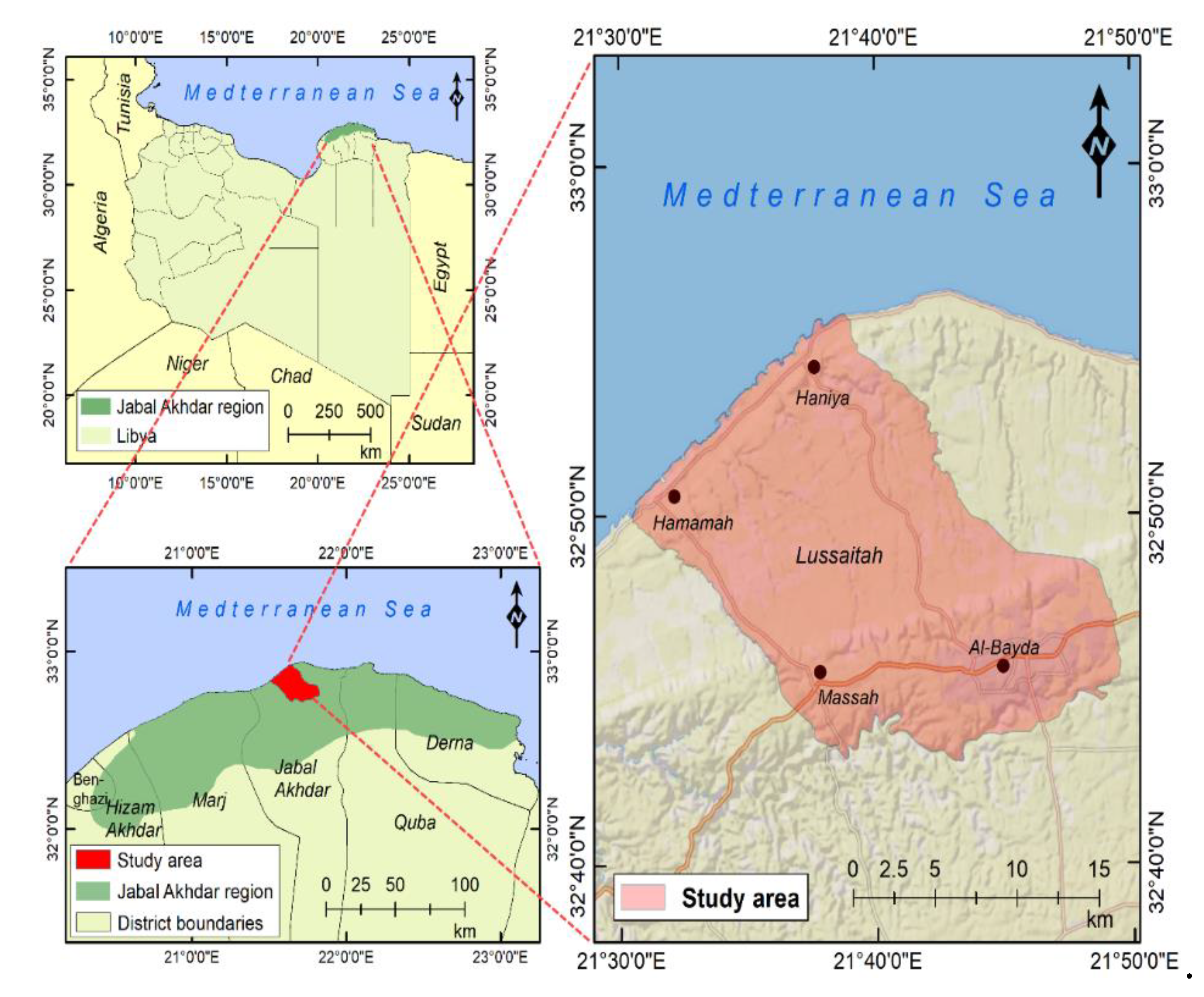
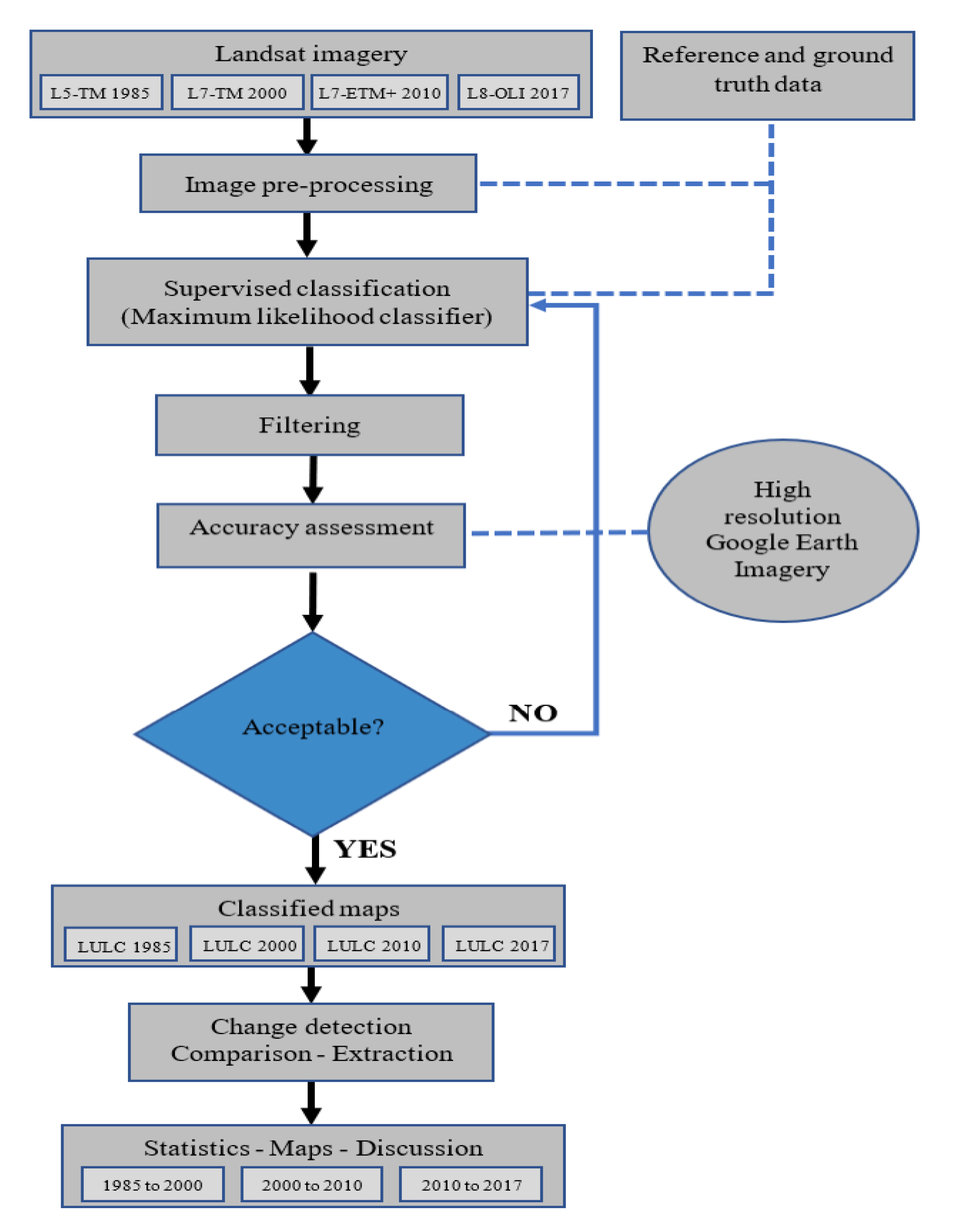
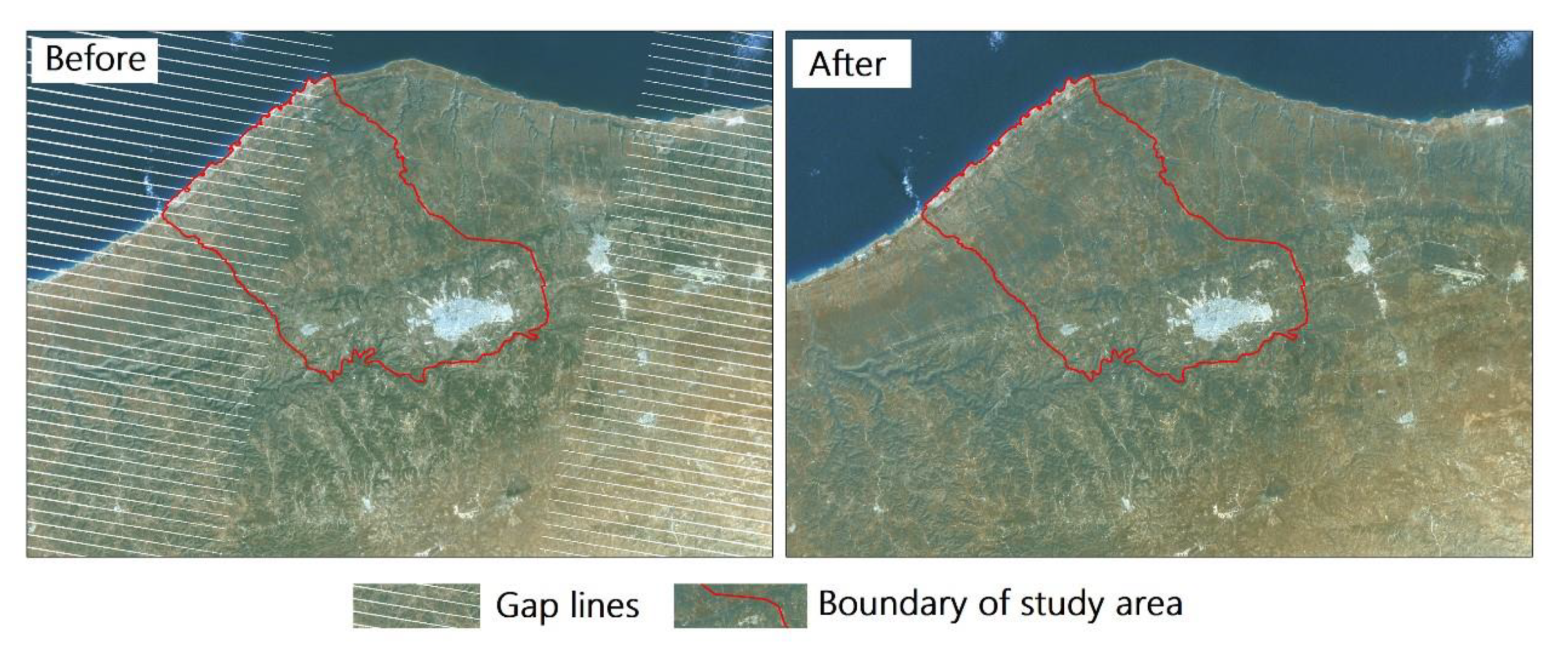
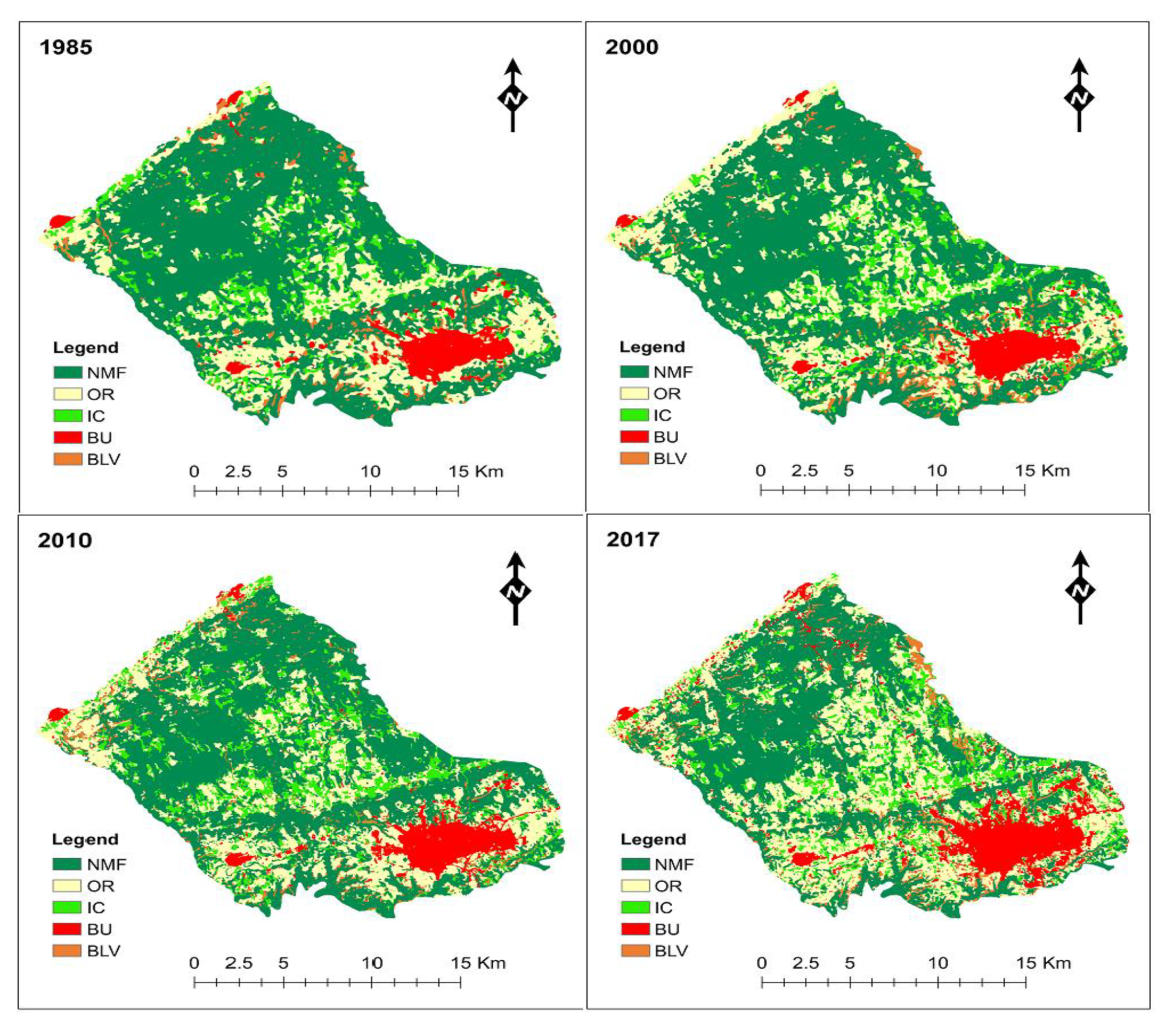
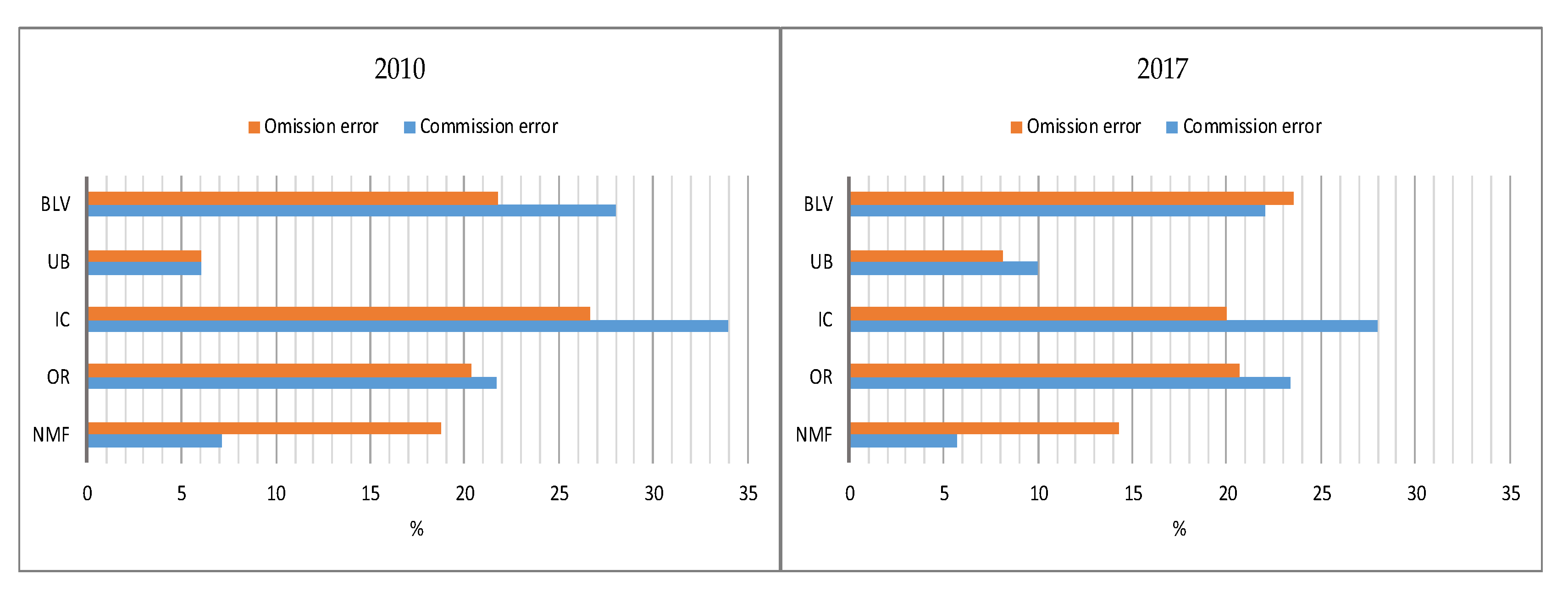
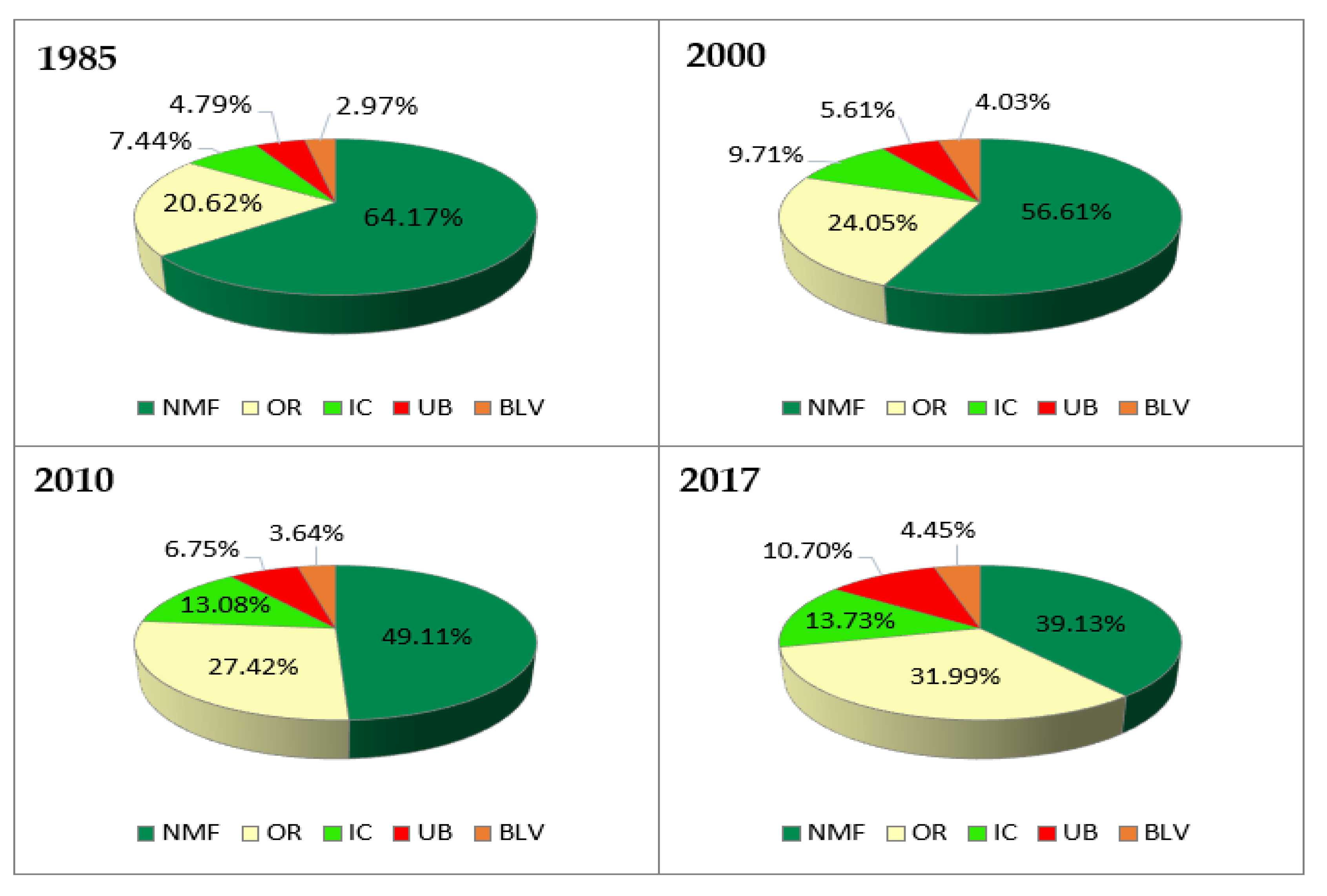
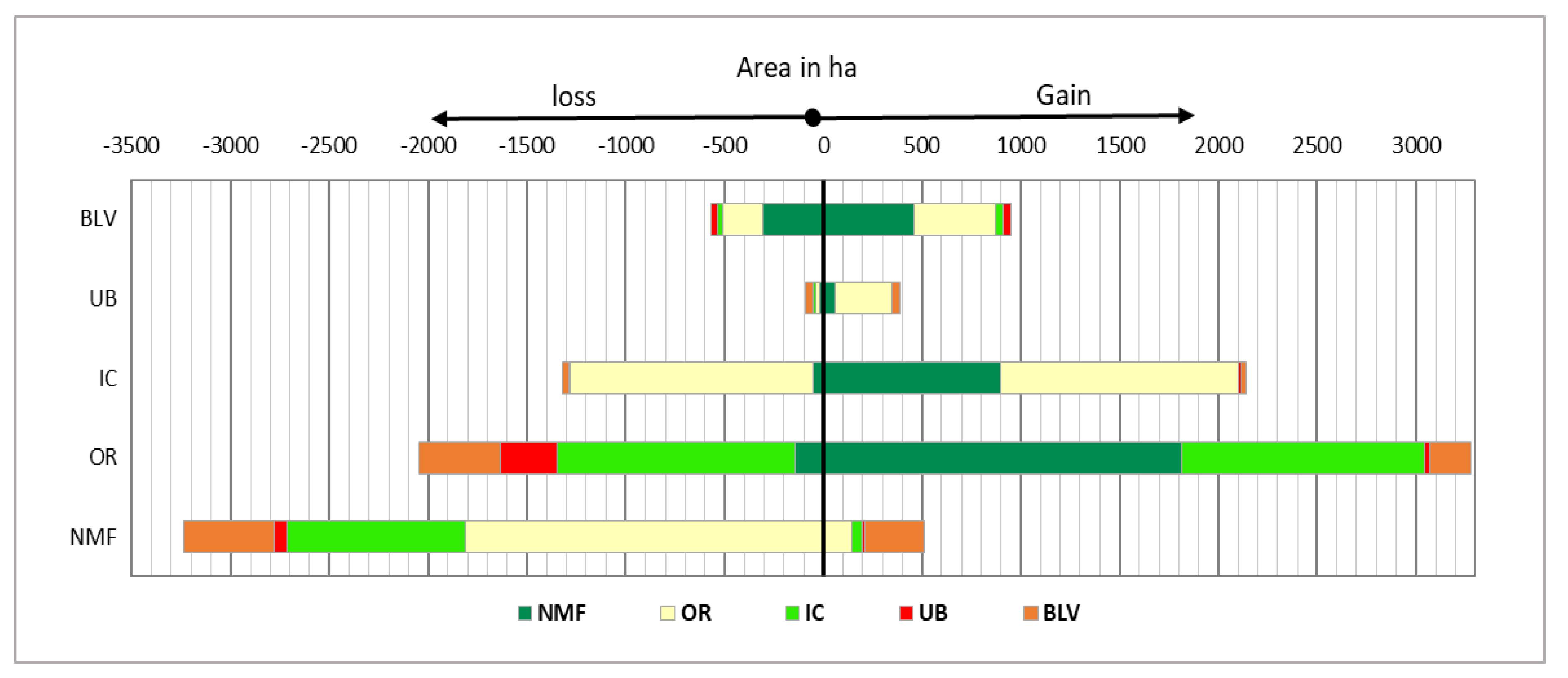
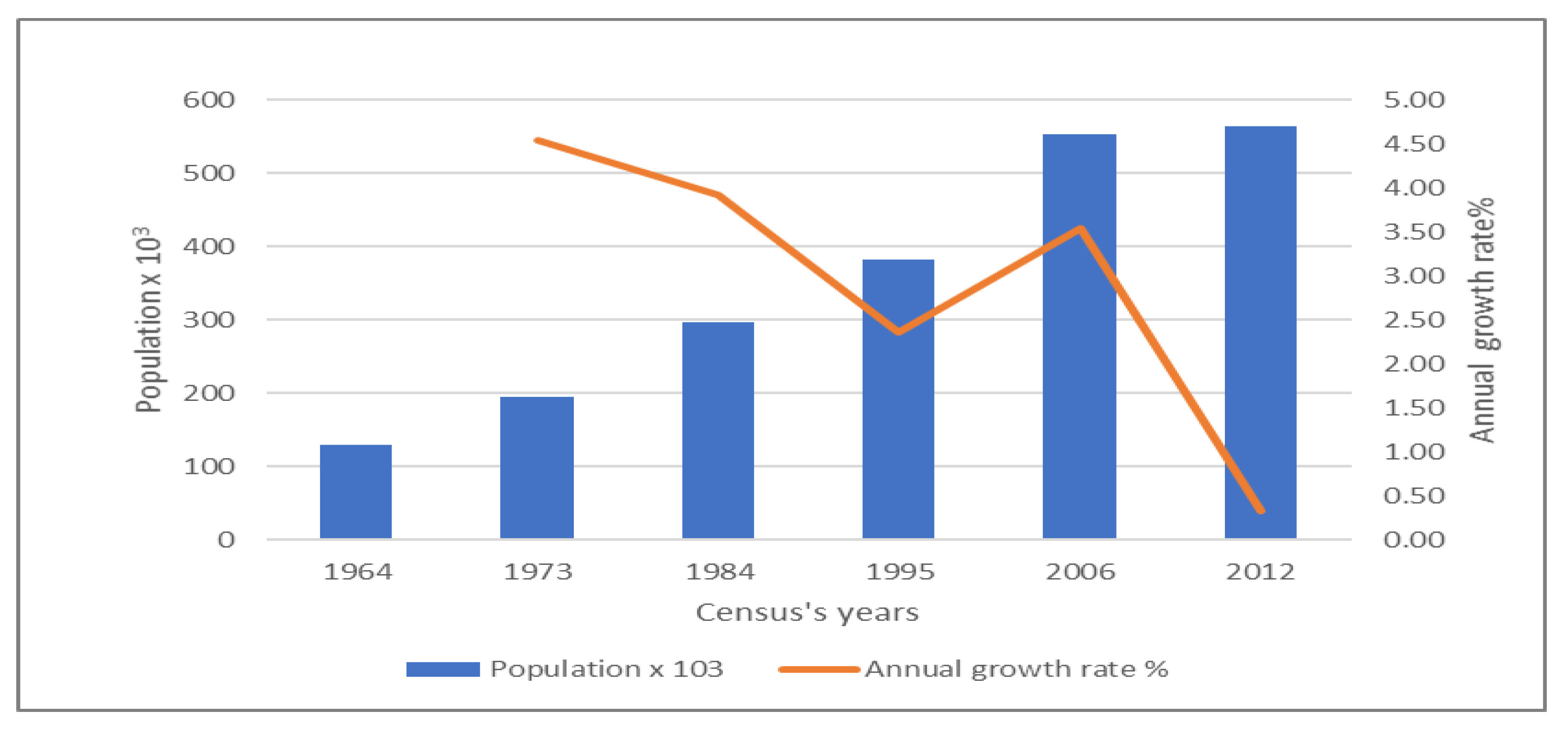
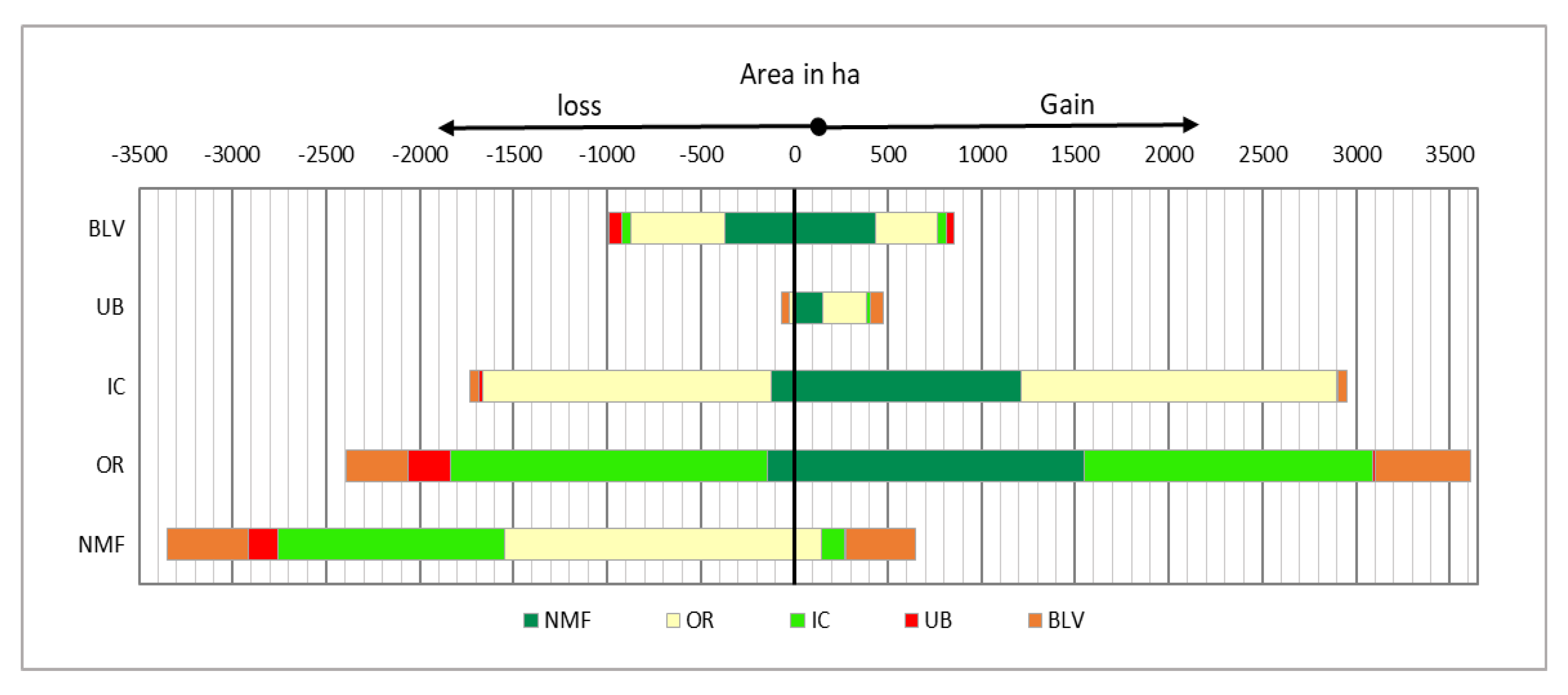

| Satellite Data | Path/Row | Image Date | Number of Bands | Spatial Resolution |
|---|---|---|---|---|
| L5 TM | 183/37 | 20/06/1985 | 7 | 30 m |
| L7 ETM+ | 183/37 | 20/05/2000 | 8 | 30 m |
| L7 ETM+ | 183/37 | 05/09/2010 | 8 | 30 m |
| L8 OLI/TIRS | 183/37 | 11/05/2017 | 11 | 30 m |
| LULC | Code | Description |
|---|---|---|
| Natural Mediterranean Forest | NMF | Areas covered by a dense evergreen natural woody vegetation known as Maquis which characterizes the Mediterranean regions, with cover reaching 70–80%, generally composed of shrubs, bushes, and trees (usually less than 6 m) |
| Orchards and Rain-fed Agriculture | OR | Agricultural lands that totally depend on rainfall for growing cereal crops and some fruit crops |
| Irrigated Crops | IC | Agricultural lands that depend on groundwater for irrigation, often cultivated as small fields for production of different vegetable crops |
| Urban and Built-up Lands | UB | Areas of intensive use where most land is covered with structures including residential, commercial, and industrial areas; buildings and farmhouses spread in the countryside are involved in this class |
| Barren and Low Vegetation | BLV | Areas with low or no vegetation including rocky areas with thin soil layer on steep slopes or in areas of severe erosion, exposed soil resulting from overgrazing or poor cultivation practices, or construction activities and areas that have been stripped of vegetation due to deliberate or accidental fires |
| Year | Overall Accuracy (%) | Kappa Statistic Khat | Mean Commission/Class (%) | Mean Omission/Class (%) |
|---|---|---|---|---|
| 2010 | 81 | 0.77 | 19.36 ± 12.47 | 18.70 ±7.69 |
| 2017 | 83 | 0.78 | 17.81 ± 9.48 | 17.33 ±6.13 |
| LULC Classes | 1985 | 2000 | Change between 1985–2000 | Annual Rate of Change 1985–2000 | ||
|---|---|---|---|---|---|---|
| Area (ha) | Area (ha) | Area (ha) | % of initial | ha.year−1 | % | |
| NMF | 23,109 | 20,385 | −2724 | −11.79 | −182 | −0.79 |
| OR | 7426 | 8659 | 1233 | 16.60 | 82 | 1.11 |
| IC | 2679 | 3496 | 817 | 30.50 | 55 | 2.03 |
| UB | 1725 | 2020 | 295 | 17.10 | 20 | 1.14 |
| BLV | 1071 | 1450 | 379 | 35.39 | 25 | 2.36 |
| Total | 36,010 | 36,010 | -- | -- | -- | -- |
| LULC Classes | 2000 | 2010 | Change between 2000–2010 | Annual Rate of Change 2000–2010 | ||
|---|---|---|---|---|---|---|
| Area (ha) | Area (ha) | Area (ha) | % of Initial | ha.year−1 | % | |
| NMF | 20,385 | 17,685 | −2700 | −13.25 | −270 | −1.32 |
| OR | 8659 | 9873 | 1214 | 14.02 | 121 | 1.40 |
| IC | 3496 | 4710 | 1214 | 34.73 | 121 | 3.47 |
| UB | 2020 | 2430 | 410 | 20.30 | 41 | 2.03 |
| BLV | 1450 | 1312 | −138 | −9.52 | −14 | −0.95 |
| Total | 36,010 | 36,010 | -- | -- | -- | -- |
| LULC Classes | 2010 | 2017 | Change between 2010–2017 | Annual Rate of Change 2010–2017 | ||
|---|---|---|---|---|---|---|
| Area (ha) | Area (ha) | Area (ha) | % of initial | ha.year−1 | % | |
| NMF | 17,685 | 14,091 | −3594 | −20.32 | −513 | −2.90 |
| OR | 9873 | 11,521 | 1648 | 16.69 | 235 | 2.38 |
| IC | 4710 | 4945 | 235 | 4.99 | 34 | 0.71 |
| UB | 2430 | 3852 | 1422 | 58.52 | 203 | 8.36 |
| BLV | 1312 | 1601 | 289 | 22.03 | 41 | 3.15 |
| Total | 36,010 | 36,010 | -- | -- | -- | -- |
© 2020 by the authors. Licensee MDPI, Basel, Switzerland. This article is an open access article distributed under the terms and conditions of the Creative Commons Attribution (CC BY) license (http://creativecommons.org/licenses/by/4.0/).
Share and Cite
Alawamy, J.S.; Balasundram, S.K.; Mohd. Hanif, A.H.; Boon Sung, C.T. Detecting and Analyzing Land Use and Land Cover Changes in the Region of Al-Jabal Al-Akhdar, Libya Using Time-Series Landsat Data from 1985 to 2017. Sustainability 2020, 12, 4490. https://doi.org/10.3390/su12114490
Alawamy JS, Balasundram SK, Mohd. Hanif AH, Boon Sung CT. Detecting and Analyzing Land Use and Land Cover Changes in the Region of Al-Jabal Al-Akhdar, Libya Using Time-Series Landsat Data from 1985 to 2017. Sustainability. 2020; 12(11):4490. https://doi.org/10.3390/su12114490
Chicago/Turabian StyleAlawamy, Jamal Suliman, Siva K. Balasundram, Ahmad Husni Mohd. Hanif, and Christopher Teh Boon Sung. 2020. "Detecting and Analyzing Land Use and Land Cover Changes in the Region of Al-Jabal Al-Akhdar, Libya Using Time-Series Landsat Data from 1985 to 2017" Sustainability 12, no. 11: 4490. https://doi.org/10.3390/su12114490
APA StyleAlawamy, J. S., Balasundram, S. K., Mohd. Hanif, A. H., & Boon Sung, C. T. (2020). Detecting and Analyzing Land Use and Land Cover Changes in the Region of Al-Jabal Al-Akhdar, Libya Using Time-Series Landsat Data from 1985 to 2017. Sustainability, 12(11), 4490. https://doi.org/10.3390/su12114490






